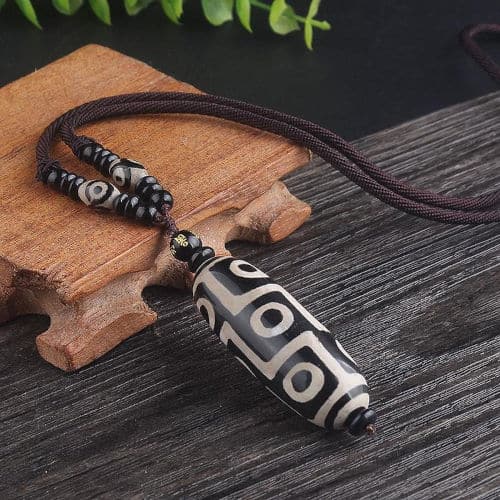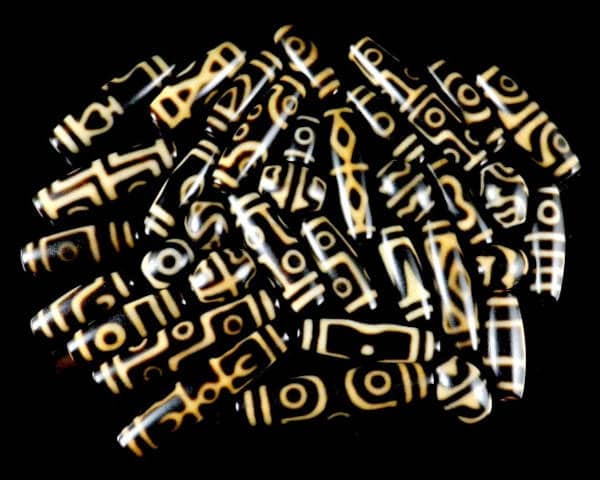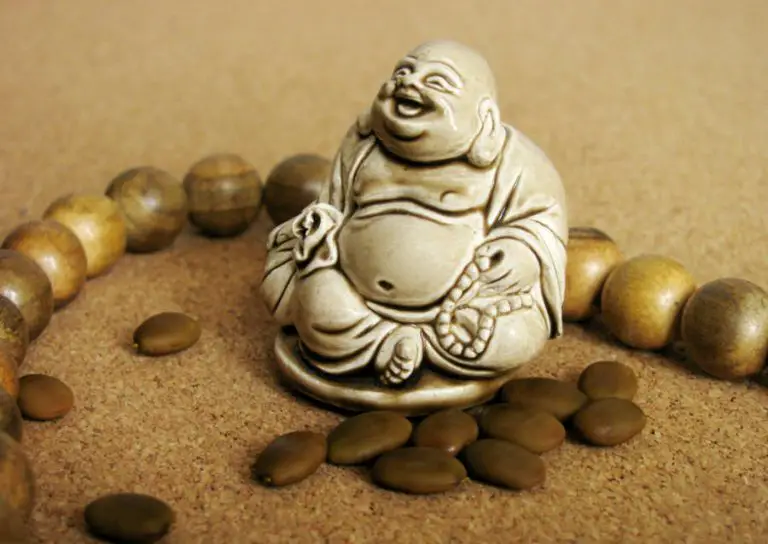The Dzi bead is one of the most popular items in Chinese Feng Shui, and almost all Feng Shui stores and online stores sell at least one variation of Dzi beads.
Because they come in beads shape, the most common way to use the Dzi beads as a Feng Shui cure is as jewelry like a necklace or bracelet, but we can also display the beads in certain areas of your home or workplace, as the Dzi Beads are believed to protect the area from negative energy while attracting good fortune for the owner.
In this guide, we will take a look at some interesting facts about the Dzi beads.
Dzi Beads Meaning and Origin
The name “Dzi” isn’t actually Chinese, but rather a Tibetan word pronounced as “zee” which can be translated to shine, brightness, or splendor. The Chinese name of the Dzi beads is 天珠 (Tiān zhū) which can be translated as “Heaven’s bead”.
The actual origin of the Dzi beads is unknown, but ancient Dzi Beads are made of natural agate. Most Dzi Beads you find in the Feng Shui store are modern-made also from agate. Genuine ancient Dzi Beads are very rare, and so they tend to be extremely expensive.
While, as discussed, the origin of the Dzi Beads is still shrouded in mystery, most experts believe that they were made by ancient humans from natural agate by carving markings and patterns on the stone.
To Tibetans and Himalayan people, however, Dzi beads are believed are spiritual stones fallen from Heaven and an owner of genuine Dzi Beads is believed to be rewarded by good karma.
Related reading: “Chinese Good Luck Charms To Bring Good Fortune” –Opens in new tab
Tibetans believe that genuine Dzi absorbs cosmic energy from the universe, and so they are considered very powerful as amulets. You can find genuine Dzi beads in Tibetan temples decorating the most revered relics and statues, and they are believed to protect the area from evil, attract good fortune, and protect the owner from negative energy, illness, and physical harm.
In Tibet, it’s quite common to find Tibetans that believe genuine Dzi beads can protect the wearer even from gunshots.
Genuine Dzi beads are found primarily in Tibet, but you can also find them in other Himalayan areas like Bhutan and Sikkim. Many Tibetan farmers and shepherds often find Dzi Beads while cultivating fields inside the ground.
This, further adds to the mystery of the Dzi Bead’s origin: how can they be man-made since they are found inside the earth? This mystery, and rarity, makes the Dzi Beads among the most sought-after stones on Earth.
Dzi Beads may have decorative symbols from circles, squares, ovals, waves, stripes, and other patterns. The more unusual the decoration is, the more expensive and prized the Dzi Beads will be. Opaque Dzi beads are typically more expensive than translucent ones, and the most expensive Dzi Beads often come in opaque dark brown or opaque black.
Another famous legend said that the Dzi were once magical insects that live in a type of nest called Dzi Tshang. These insects eventually become petrified in the form of today’s Dzi Beads.
There is also another story of how the compassionate Vajravarahi Buddha released the magical Dzi Beads from Heaven to help the Tibetans during a severe epidemic crisis.
Related reading: “A Concise Timetable of Feng Shui History“ –Opens in new tab

Types of Dzi Beads
Dzi beads are commonly classified by the number of “eyes” they possess, which are the circular patterns that can be found on the Dzi. Some Dzi Beads don’t have any eyes at all, but some have up to 12 and even 21 eyes. Here are the meanings behind the number of the eyes on a Dzi Bead:
- 1 eye: enhancing the owner’s wisdom and bringing happiness
- 2 eyes: improving career luck, encourage love and harmony for a married couple, goof relationship (and friendship) luck in general
- 3 eyes: brings happiness, honor, and long-life
- 4 eyes: ward off bad luck and purifying obstacles in life
- 5 eyes: a popular number, believed to grant whatever the owner desires. Believed to bring unlimited happiness and good luck in wealth.
- 6 eyes: warding off miseries and bad luck
- 7 eyes: helping the wearer to achieve career advancement, fame, wealth, and luck in health and relationship
- 8 eyes: protecting the wearer from calamities
- 9 eyes: another very popular pattern, believed to help the wearer to enhance their luck in wealth, authority and protecting the wearer from negative energy
- 10 eyes: remove obstructions in career advancement and improve relationship harmony
- 11 eyes: improving the wearer’s inner consciousness to achieve peace of heart and mind
- 12 eyes: aiding the wearer in achieving fame and authority
- 13 eyes: a mystical Dzi, believed to enable the wearer to communicate with their late ancestors
- 14 eyes: clear the wearer’s mind from karmic issues
- 15 eyes: enhance the wearer’s wisdom and improves their fortune
- 16 eyes: helps in eliminating sadness and bringing joy to the wearer’s life
- 17 eyes: building your self-esteem and appear more confident
- 18 eyes: protecting the wearer from depression, pressure, and excessive obsessions
- 19 eyes: granting the wearer’s life wishes
- 20 eyes: for energy purification and health
- 21 eyes: combining all the benefits of all the other beads into one, maximum fortune
Take a look at these “Dzi beads designs” – Aff.link
Dzi beads, however, can come in various different shapes including:
- Carnelian (translucent) Dzi Beads, called Chung Dzi
- Cylindrical (long-sized)
- Cylindrical (short-sized)
- Un-even shape
- Oval
- Round (like a ball)
- Round and flat (like a coin)
Also, you can find, various designs and decorations on Dzi Beads, including but not limited to:
- Fire Burial
- Garuda Healing
- Monsignor
- Mountain, Peak or Hill
- Nectar Bottle
- Heart
- Heaven & Earth
- Insect
- Banded and striped dZi
- Bat dZi
- Bodhi dZi
- Da Ren
- Dharma
- Diamond
- Dorje
- Dragon eyes
- Dragon skin
- Eagle’s mouth
- Earth Sky
- Monsignor
- Mountain or Hill
- Nectar Bottle
- Star
- Tiger Tooth
- Turtle Back
- Kwan Yin
- Kubera
- Lightning
- Lotiform
- Lotus
- Medicine
Want to learn more about Feng Shui? Take a look at these Courses and Books – Aff.link
How To Wear Dzi Beads
As discussed, the most common way to use Dzi Beads as a good luck charm is to wear them as jewelry. Wearing the Dzi Beads as jewelry is believed to transform the owner’s wisdom and improves the owner’s inner consciousness while providing benefits like attracting good luck and warding evil.
Here are some tips to consider when wearing the Dzi Beads as jewelry:
- As a general rule of thumb, the Dzi Bead should touch your skin when worn (on your hand, neck, waist, leg, etc.) instead of your clothes. This is so that the Dzi Bead can blend with your body’s natural aura and energy.
- Remove the Dzi Bead jewelry when taking a bath. While it’s okay for the Dzi Beads to touch water (in fact, you should clean them with water from time to time, more on this later), the string that holds the Dzi Beads in necklace/bracelet form might break from frequent contact with water.
- Remove the Dzi Bead jewelry when performing acts that might be disrespectful (i.e. throwing the trash, etc.) to prevent the Dzi from mixing with negative energy.
- Replace the Dzi Beads as soon as possible if any of them break. Take extra care of accidentally dropping or knocking the Dzi Beads when performing activities like changing clothes.
- When the Dzi Beads jewelry is not worn, consider placing it on a dedicated Feng Shui altar to preserve its energy.
Related reading: “Chinese Good Luck Charms To Bring Good Fortune” –Opens in new tab

How To Clean Dzi Beads
Here are some tips you can use to clean your Dzi Beads:
- Use a glass/cup or a small bowl to hold warm water mixed with 10 grams of Yushou salt. Soak the Dzi Beads in the water for at least 24 hours. You can dry the Dzi Beads with a soft cloth (avoid cotton when you can). Washing the Dzi Beads with Yushou salt monthly can remove dead skin cells from the surface, preventing fungal growth while at the same time protecting your skin from skin diseases.
- Once a week or every few days, you can soak the Dzi Beads in the Yushou salt solution for around 30 minutes. You can use a small brush to brush the Dzi Beads lightly while soaked in the solution.
- You should use a dry towel to wipe the Dzi Bead’s surface every few days to dust it off and also to remove wax and other dirty materials.
- Lay the Dzi Beads outdoor for natural drying from time to time before and after you soak them in Yushou salt solution
End Words
There is a growing popularity for Dzi Beads among Feng Shui practitioners and those who believe in the mystical powers of gems.
When purchasing Dzi Beads, keep in mind that most beads you’ll find on the market, especially on common Feng Shui stores are just immitations of ancient Dzi Beads, but a lot of them are made with great quality and can still provide the Feng Shui benefits.
The prices of these modern-made Dzi Beads can vary greatly starting from just $20, but genuine, ancient Dzi Beads can be extremely expensive.
Most desired Dzi Beads are made from Agate or Carnelian material and come in various designs and patterns. You can, however, also find Dzi Beads in other materials such as wood, ceramics, glass, and even plastics.
Take a look at these “Dzi beads designs” – Aff.link
Stay in Touch
 Join our newsletter by using the forms on this website or click here!
Join our newsletter by using the forms on this website or click here! Follow us on Google News
Follow us on Google News Follow us on Facebook
Follow us on Facebook





